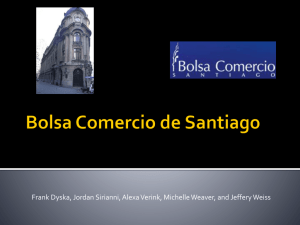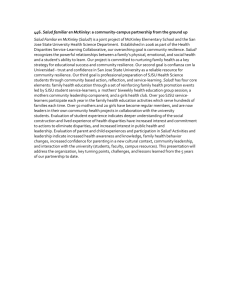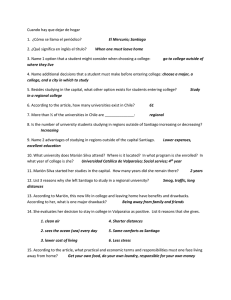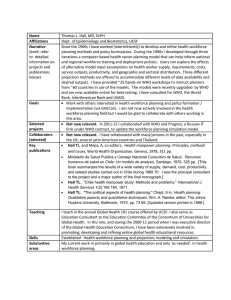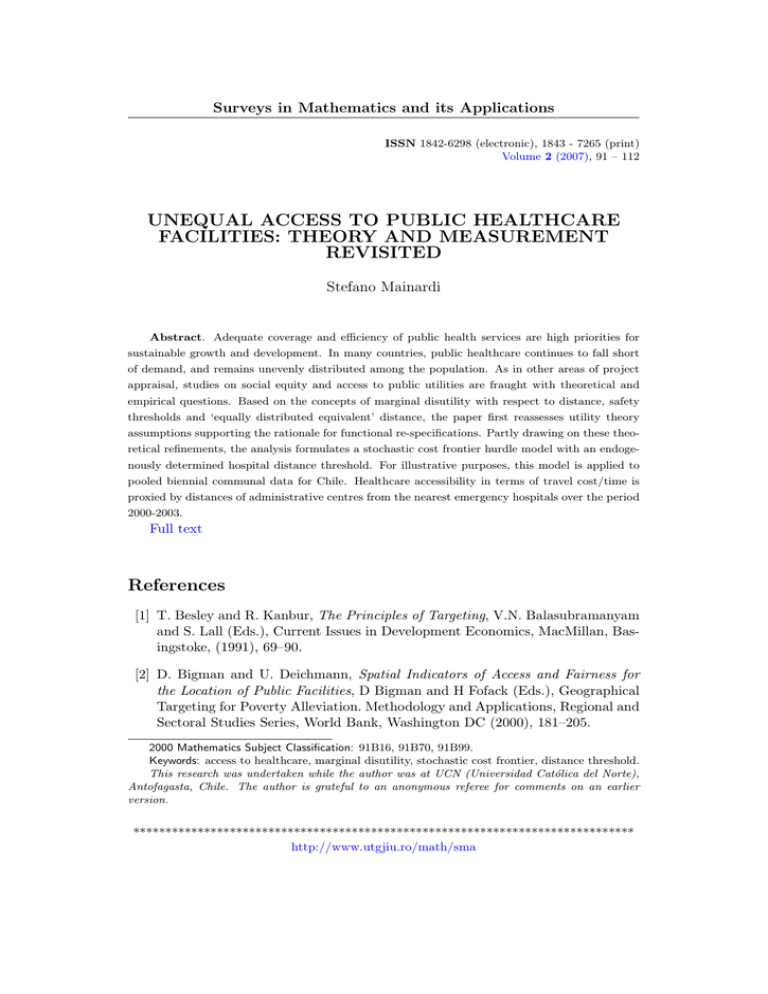
Surveys in Mathematics and its Applications
ISSN 1842-6298 (electronic), 1843 - 7265 (print)
Volume 2 (2007), 91 – 112
UNEQUAL ACCESS TO PUBLIC HEALTHCARE
FACILITIES: THEORY AND MEASUREMENT
REVISITED
Stefano Mainardi
Abstract. Adequate coverage and efficiency of public health services are high priorities for
sustainable growth and development. In many countries, public healthcare continues to fall short
of demand, and remains unevenly distributed among the population. As in other areas of project
appraisal, studies on social equity and access to public utilities are fraught with theoretical and
empirical questions. Based on the concepts of marginal disutility with respect to distance, safety
thresholds and ‘equally distributed equivalent’ distance, the paper first reassesses utility theory
assumptions supporting the rationale for functional re-specifications. Partly drawing on these theoretical refinements, the analysis formulates a stochastic cost frontier hurdle model with an endogenously determined hospital distance threshold. For illustrative purposes, this model is applied to
pooled biennial communal data for Chile. Healthcare accessibility in terms of travel cost/time is
proxied by distances of administrative centres from the nearest emergency hospitals over the period
2000-2003.
Full text
References
[1] T. Besley and R. Kanbur, The Principles of Targeting, V.N. Balasubramanyam
and S. Lall (Eds.), Current Issues in Development Economics, MacMillan, Basingstoke, (1991), 69–90.
[2] D. Bigman and U. Deichmann, Spatial Indicators of Access and Fairness for
the Location of Public Facilities, D Bigman and H Fofack (Eds.), Geographical
Targeting for Poverty Alleviation. Methodology and Applications, Regional and
Sectoral Studies Series, World Bank, Washington DC (2000), 181–205.
2000 Mathematics Subject Classification: 91B16, 91B70, 91B99.
Keywords: access to healthcare, marginal disutility, stochastic cost frontier, distance threshold.
This research was undertaken while the author was at UCN (Universidad Católica del Norte),
Antofagasta, Chile. The author is grateful to an anonymous referee for comments on an earlier
version.
******************************************************************************
http://www.utgjiu.ro/math/sma
2
Stefano Mainardi
[3] D. Bigman, S. Dercon, D Guillaume and M Lambotte, Community Targeting for
Poverty Reduction in Burkina Faso, World Bank Economic Review, 14 (2000),
no. 1, 167-193.
[4] D. Bigman, and H Fofack, Geographical Targeting for Poverty Alleviation: An
Introduction to the Special Issue, World Bank Economic Review, 14 (2000), no.
1, 129-145.
[5] L.Bixby and D Güell, Oferta y acceso a los servicios de salud en Costa Rica:
estudio basado en un sistema de información geográfica (GIS), Investigaciones
en Salud Pública (Documentos Técnicos), (1999) División de Salud y Desarrollo
Humano, PAHO-WHO, Washington DC.
[6] R J. Brent, On the Estimation Technique to Reveal Government Distributional
Weights, Applied Economics, 23(1991), 985-992.
[7] R J. Brent, Project Appraisal for Developing Countries, Harvester Wheatsheaf,
Hemel Hempstead, 1990.
[8] C. Calderón Moncayo, El hospital de Chaitén, Futaleufú y Palena está en ...Argentina, El Mirador de Cicalmo, (2006), Nov. 19.
[9] J-Y. Duclos, Vulnerability and Poverty Measurement Issues for Public Policy,
Social Protection Discussion Paper Series, 0230 (2002), World Bank, Washington DC.
[10] G. Dussault and M. C. Franceschini, Not Enough There, Too Many Here: Understanding Geographical Imbalances in the Distribution of the Health Workforce, Human Resources for Health 4 (2006), no. 12. (http://www.humanresources-health.com/).
[11] D. Evans, A Tandon, C Murray and J Lauer, The Comparative Efficiency of
National Health Systems in Producing Health: An Analysis of 191 Countries,
GPE Discussion Paper Series, 29 (2001), WHO, Geneva.
[12] M. Farsi, M Filippini and M Kuenzle, Unobserved Heterogeneity in Stochastic
Frontier Models: A Comparative Analysis, Quaderno N. 03-11 (2003), University of Lugano.
[13] G. Fields, Should Poverty and Inequality Measures Be Combined?, mimeo, Cornell University, 2003.
[14] D. Filmer, J. Hammer and L Pritchett, Health Policy in Poor Countries: Weak
Links in the Chain, mimeo, World Bank, Washington DC 1997.
******************************************************************************
Surveys in Mathematics and its Applications 2 (2007), 91 – 112
http://www.utgjiu.ro/math/sma
Unequal access to public healthcare facilities
3
[15] R. Fischer, R Gutiérrez and P Serra, The Effects of Privatization on Firms
and on Social Welfare, Serie economı́a, 131 (2002) CEA, Universidad de Chile,
Santiago.
[16] J. Foster, J. Greer and E. Thorbecke, A Class of Decomposable Poverty Measures, Econometrica, 52 (1984) no.3, 761-766. Zbl 0555.90029.
[17] E. Gadikou, C Murray and J Frenk, Measuring Preferences on Health System Performance Assessment, GPE Discussion Paper Series, 20 (2000), WHO,
Geneva.
[18] W. H. Greene, Distinguishing between Heterogeneity and Inefficiency: Stochastic Frontier Analysis of the WHO’s Panel Data on National Health Care Systems, mimeo, Stern School of Business, New York University, 2003.
[19] W. H. Greene, Econometric Analysis, Pearson/Prentice Hall, New Jersey, 2003.
[20] W. H. Greene, LIMDEP Version 7.0. User’s Manual, Econometric Software
Inc., New York, 1998.
[21] S. Gupta, M. Verhoeven and E Tiongson, Does Higher Government Spending Buy Better Results in Education and Health Care?, IMF Working Papers,
WP/99/21, 1999.
[22] R. Johnson, and R. Schoeni,Health Dynamics and the Evolution of Health Inequality over the Life Course: The Importance of Neighborhood and Family
Background, mimeo, University of Michigan, 2003.
[23] M. Keane, and R. Moffitt, A Structural Model of Multiple Welfare Program
Participation and Labor Supply, International Economic Review, 39 (1998) no.
2, 553-589.
[24] O. Larrañaga, Eficiencia y equidad en el sistema de salud chileno, Serie Financiamiento del Desarrollo, 49 (1997), CEPAL, Santiago.
[25] Ministerio de Planificación (Mideplan), Pobreza y distribución del ingreso en
las regiones, Serie CASEN, División Social, Santiago, 2004.
[26] Ministerio de Salud (MINSAL) , Cuenta pública 2003 Ministerio de Salud, Santiago, 2004.
[27] MINSAL, Objetivos sanitarios para la década 2000-2010, Boletı́n de vigilancia
en salud pública de Chile, 5 (2002), no. 15, Santiago.
[28] MINSAL - Pontificia Universidad Católica (PUC),Resultados I Encuesta de
Salud, Chile 2003, Departamento de Epidemiologı́a, Santiago, 2004.
******************************************************************************
Surveys in Mathematics and its Applications 2 (2007), 91 – 112
http://www.utgjiu.ro/math/sma
4
Stefano Mainardi
[29] S. Neira, Volar...o morir en Chaitén, El Mercurio, Oct. 4, Santiago, 2000.
[30] R. Oxoby and D. Bischak, Passing the Time: Other-Regarding Behavior and
the Sunk Cost of Time, mimeo, University of Calgary, 2005.
[31] C. Price and C .T. S. Nair, Discounting and the Distribution of Project Benefits,
Journal of Development Studies 21 (1985), no. 4, 525-532.
[32] J. Puig-Junoy and V. Ortún, Cost Efficiency in Primary Care Contracting:
A Stochastic Frontier Cost Function Approach, mimeo, Universitat Pompeu
Fabra, 2003.
[33] J. Rodrı́guez and M. Tokman, Resultados y rendimiento del gasto en el sector
público de salud en Chile 1990-1999, Serie Financiamiento del Desarrollo, 106
(2000), CEPAL, Santiago.
[34] R. E. Santerre and S. P. Neun, Health Economics. Theories, Insight, and Industry Studies, Dryden Press, Orlando, 2000.
[35] L. Squire and H. van der Tak, Economic Analysis of Projects, Johns Hopkins,
Baltimore, 1975.
[36] P. Smith and A. Street, Measuring the Efficiency of Public Services: The Limits of Analysis, Journal of the Royal Statistical Society, 168 (2005), 401- 417
MR2119408. Zbl 1100.62113.
[37] Secretariat for Regional and Administrative Development (SUBDERE) - Pontificia Universidad Católica (PUC), Diagnóstico y propuestas para la integración
de territorios aislados, Santiago, 1999.
[38] T. Zuehlke, Estimation of a Tobit Model with Unknown Censoring Threshold,
Applied Economics, 35 (2003), 1163-69.
Stefano Mainardi
Department of Informatics and Econometrics,
UKSW- Card. S. Wyszyński University,
ul. Dewajtis 5, 01815, Warsaw,
Poland.
e-mail: smainardi@interia.pl
******************************************************************************
Surveys in Mathematics and its Applications 2 (2007), 91 – 112
http://www.utgjiu.ro/math/sma

